Ahoy, squirts! Quint here. The term “movie star” gets thrown around a lot. To most people it simply means someone who is famous (even if temporarily) for starring in a film. To me there are famous actors and there are movie stars. The latter describes an actor who is so huge in their moment, who radiates charm and charisma to such a degree, that they become an icon, a legend.
Burt Reynolds is a movie star.
This man ruled the '70s and early '80s, not only in terms of box office draw, but also in exposure. Burt Reynolds was there every time you turned on your TV, being interviewed on talk shows or appearing on game shows or being discussed in the news.
Much of this omniscience is glimpsed in the fantastic Jesse Moss documentary THE BANDIT which airs on CMT tomorrow evening and had a big premiere at SXSW where I actually got the chance to sit down with Mr. Reynolds.
This chat was a dream come true because it wasn't tied to pimping some random thing Reynolds did for a few bucks. It was specifically about talking about his work with Hal Needham, which meant he was there to discuss his best films like Smokey and the Bandit, Hooper and the Gator McKlusky movies.
Speaking of, here's a quick aside. I collect movie poster art. I'm talking about the actual paintings that became movie posters. It's a small collection (I'm not a rich man and collecting original art of any kind is a pricey hobby), but a quality one.
The crown jewel of my collection is Tom Jung's painting for the White Lightning Style B poster. In person this thing is staggeringly beautiful and vibrant. The below photo doesn't do it justice:
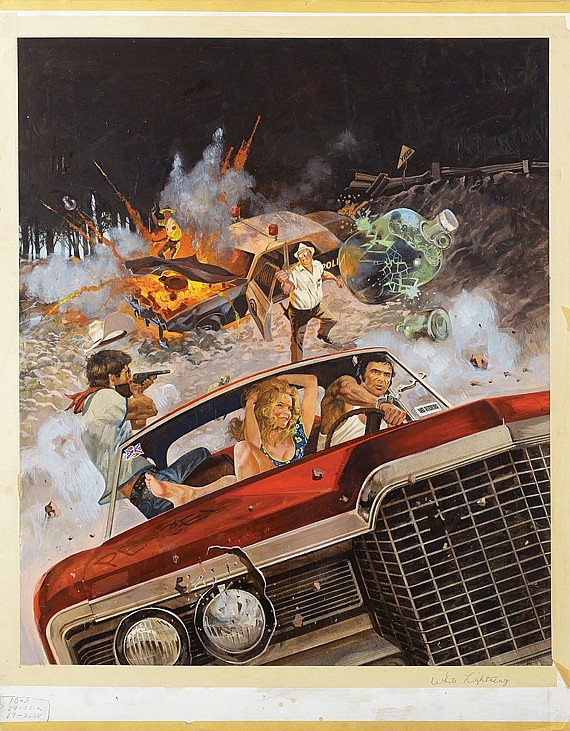
Naturally I couldn't resist bringing the art in for a show and tell, so the interview starts shortly after I walked into the room with Burt, doc director Jesse Moss and the executive director of Burt's Institue for Film & Theater, Todd Vittum, original art in hand.
Moss called it the second he saw it ("That's White Lightning!" and jumped out of his chair to get a closer look. Vittum smiled big and started asking me questions on how I got it. Burt seemed surprised it was real and started pointing out some of the details, like the angry Ned Beatty Sheriff in the background shaking his fist, and saying how well done it is up close.
The conversation itself is typical of these interviews with living legends of cinema. Reynolds is great, honest as all hell and we don't get nearly enough time to dig into his filmography as I would have liked. There may be hope for a follow up, though. At the end of the interview Reynolds shook my hand, but held on, pulled me in closer and said “I will see you again, for sure.”
I'd totally be down for a lengthy follow-up, but for now let's take a look at this Hal Needham-centric chat, which also happens to delve into Reynolds talking about being “hurt” by a young Steven Spielberg, praising Sally Field and calling himself a whore for doing Smokey and the Bandit 2.
Enjoy!
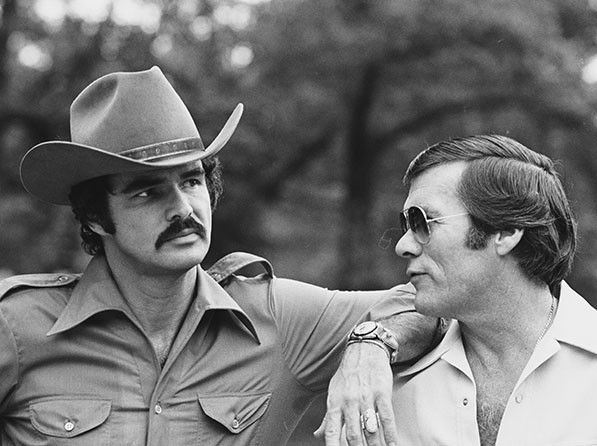
Quint: White Lightning's still one of my favorite movies of yours and the art is just amazing, so I jumped at the chance to pick this up when I saw it. Movie posters don't look like these days.
Burt Reynolds: No, they don't.
Quint: I read something about White Lightning and I don't know if it's true or not, so maybe you can clear it up for me. I heard that Steven Spielberg was originally supposed to direct it. Is that true?
Burt Reynolds: He was set to do it and something, probably good sense, told him he couldn't make a picture off the lot. I said, “Alright, we'll make it on the lot,” and he said “You can't make this picture on a lot.” He wanted out and it really hurt me. I felt like he just didn't want to work with me, that was the reason. And he didn't.
Quint: Do you really think that was the reason or do you think he had people pushing him in other directions?
Burt Reynolds: Well, he was right on the cusp of breaking out as a big director. No matter how you looked at that script or how much you worked on it, it was B-movie. You could make it as good as you could, and he could have probably made it very good, but...
Quint: I see why he was a good fit for it at that time. He had done Duel for TV and Sugarland Express, which are both very exciting road pictures.
Burt Reynolds: Duel was fabulous.
Quint: When you have a script by Richard Matheson you're already halfway to making something special, but his visual style was impeccable, even then.
Burt Reynolds: I thought his visual style was everything. Everything. It made the picture incredible.
Quint: Well, I'm bummed for you that Spielberg didn't do it, but as a fan I'm happy with the way White Lightning turned out. Maybe he would have messed it up! You never know.
Burt Reynolds: We had a good director. He was damn good. Joe Sargent.
Todd Vittum: He was quite the character. He was arrested for smuggling guns for Ireland. He spent time in a Cuban prison and finally died in Mexico, I think.
Quint: Unlike Spielberg, who I don't imagine has smuggled guns for anybody.
Burt Reynolds: No. (laughs)
Quint: Well, I gotta say I loved the doc. I might be an easy target because I'm a big fan of your work, especially in the time period and especially with Hal. It was very smart to focus the documentary on your friendship with Hal and it lets people like me who never had the chance to meet him understand a little bit what he was like as a person. Did that approach make it easy for you to get involved?
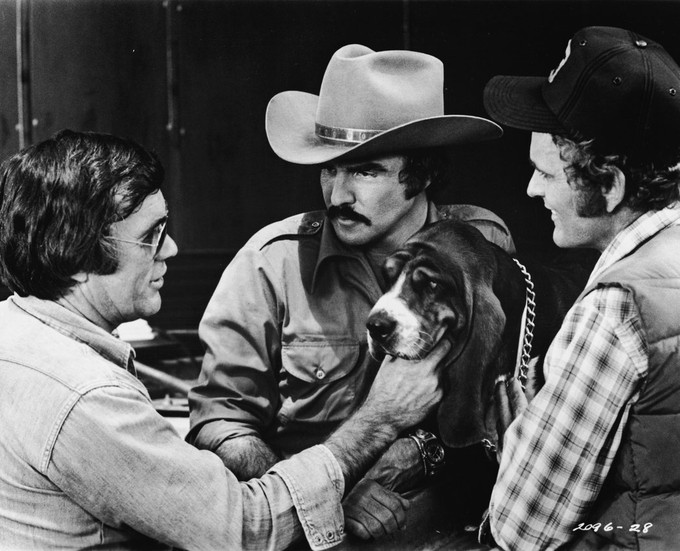
Burt Reynolds: I loved him like a brother. He was my brother. We were so close. I would have bet on him in a dog race, in anything. He was just an amazing man. We'll never find another like him. The stunt world won't. When he left the original (stunt group) and formed Stunts Unlimited, boy did he take the cream of the crop. The guys he took, he took 6 or 7 guys, and then picked up a bunch of young guys who were just starting, but you couldn't go wrong with any of those guys.
Jesse Moss: That could have been a film unto itself. That was one of the challenges of the documentary. How do we contain it? There's a lot to talk about. I will say that right away I knew this film should be about the relationship between Burt and Hal. It was a buddy movie about a buddy movie.
I was talking to CMT about it and the original conception was more about Smokey and the Bandit's legacy. I went away and read about the film and (Burt's) relationship and said, “No, this is the core of the documentary.” And through that we can explore your other films and Hal's career, but it was really about your relationship and what you risked in making this film.
Burt Reynolds: His wife kicked him out and I told him he could stay with me for a week or two. Five years later he was still there!
Jesse Moss: David Needham says 12 years and I've heard 10 years. Maybe it's five?
Burt Reynolds: You know what? It might have been 10. It might have been. (laughs)
Jesse Moss: In making the documentary and wanting to understand what it was like for you guys to share this house together... I know he was very protective of you, right?
Burt Reynolds: I never saw him!
Jesse Moss: Because you guys were working so much?
Burt Reynolds: Outside of my house I had another little house by the pool (where Hal stayed), so I never saw him when he came in, I never saw him when he went out. You're right, he was so protective of our relationship.
Quint: I love seeing a real documenting of a friendship like this. A lot of the time the reporting on stuff like this is of the tabloid nature. You don't see them focusing on people really having each others' backs. I love that you took a chance on him with a script that wasn't ready, but did so because you believed so strongly in him.
Burt Reynolds: That's right.
Quint: It was the right thing for you to do as a friend and in doing so you also happened to make one of the highest grossing films of the era. I'd love it if you could talk a little bit about coming out of making Smokey and the Bandit and realizing you had something that worked, that was a crowd-pleaser. Did that change anything in your life or your relationship with Hal?
Burt Reynolds: It changed everything for me. Because of how much money it made. I had been in this class (holds hand up) and suddenly I was in that class (raises hand up higher), working with Spielberg and people like that and it was all because of Hal. He had this amazing ability to bring action that wasn't just stupid action. It wasn't the kind of action you see in pictures today that makes me crazy. It was the real thing.
I used to stand in awe at what he was getting. The stunt men idolized him, so they weren't going to let him down. So they took more of a chance than they had to take when they did the stunts. They went higher than he said. It was fabulous to see.
Quint: I can only imagine that when you see everybody really committing that made you step up your game as well.
Burt Reynolds: That's right.
Jesse Moss: The stakes were real. (Producer) Mort Engelberg, who interviewed for the documentary, was pretty freaked out, I think, at how fast those guys were moving and how close to the edge they needed to get to to make it work. It was painful to not get into Hooper, which is a movie we love and is a tribute, in a way, to Hal himself. But we had to end the documentary with the release of Smokey.
Quint: That's why you need to go make a Part 2! I could watch 3 hours on Hooper. I still don't understand how those car stunts were done!
Burt Reynolds: (laughs)
Quint: Seriously! The whole movie is telling you “This is going to be the most amazing car stunt you've ever seen, just wait and see!” and if it wasn't the most amazing thing you've ever seen the whole movie falls in on itself, but it is!
Jesse Moss: When the smokestacks collapse? It's amazing.
Burt Reynolds: That was by inches. I was in that car and I wasn't happy. I said, “Go, go, go!”
Jesse Moss: It was great to be able to go back in time and see the barge jump in White Lightning and see his early stunt work and even the stunts you did. It was awesome to explore your relationship through that stunt work.
Burt Reynolds: We were only missing Sally Field (from White Lightning). Jennifer Billingsley didn't cut it. She was a nice girl, but she didn't have the chops. You have to have a real super leading lady on a picture like that.
Quint: That's one of the secrets of both Smokey movies you did together. That relationship is so fun, the charisma between the two of you is off the charts. One scene that always sticks out for me in Smokey is that bit after the bridge jump and Sally is more excited about it than even anyone in the audience! It's such a childlike, very real excitement that is super infectious.
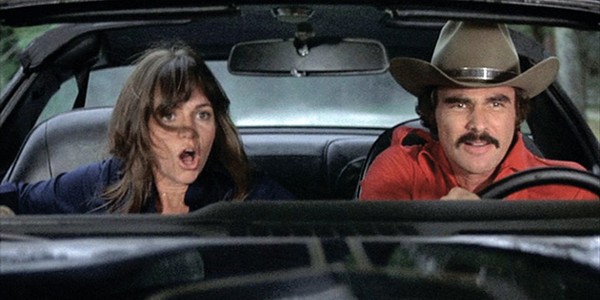
Burt Reynolds: That was her decision. It wasn't the director or me that said “We need you to come over our side and get all jacked up about this.” She just did it. I didn't know she was going to do it or go that far with it.
Jesse Moss: So, Universal didn't keep a lot of behind the scenes material. First of all, there wasn't much done for Smokey because they didn't think it was going to be a big hit. Universal discarded a lot of stuff, but we were lucky to find those outtakes of you and Sally in the car that Hal Needham showed on the Dinah Shore Show. That's the only outtake material on the film. It was wonderful to see you guys improvising in the car together.
Burt Reynolds: I was in awe of her. I knew she was a hell of an actress, but she was so brilliant.
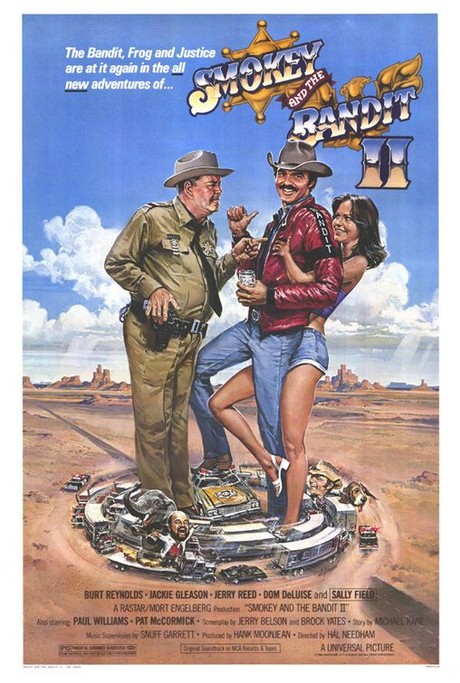
Quint: Can you talk a little about moving from Smokey 1 to Smokey 2? The first one really does feel like a group of friends got together and had a good time, but the second one is after that success and feels more like studio product. Was the studio more hands on now that they thought they had a franchise on their hands?
Burt Reynolds: It was that. I wasn't happy at all with the second one. They were making it for the money and we were whores, too. We played along. I wish we hadn't. You know, there are some pictures that just don't deserve a sequel. You should walk away from it.
Quint: Is that why you and Hal didn't want to take part in Smokey 3?
Burt Reynolds: Oh, God. That was awful. I visited... they were down in Delray and I drove down and walked up. Everybody was happy I was there and all that and (the director) said “Can I just shoot one scene (with you)?” I thought, “I shouldn't have come down here, this is stupid,” but I said “Yeah, okay.” I really hated myself for doing that.
Quint: I think you're beating yourself up for that cameo more than your fans would.
Burt Reynolds: Well, thank you.
Quint: As much as I love your work in front of the camera, I'm also a fan of your work behind the camera, too. I remember seeking out The End early on because I was a fan of Dom DeLuise.
Burt Reynolds: He should have been nominated. He was so great. That thing where he goes up to knock on the door. That's just brilliant. That's as good as it gets. I miss him. Talk about irreplaceable.
Quint: (To Jesse) Now you have another movie to make, this time about Burt's relationship with Dom!
Jesse Moss: After I make the Hooper documentary.
Quint: You better start cranking them out because I want to see them!
Jesse Moss: This film was a very special opportunity. I mean, I can't believe Burt agreed to it.
Burt Reynolds: Absolutely, because I know you love film and you love that film. You love the same films I do.

After the interview, Reynolds very graciously signed the art for me along the bottom border with the nice message “The Best Man Is Only You” and offered to take the above picture with me, Jesse Moss and the art.
The man was a class act. If we he wasn't so popular I might have been able to squeeze more than 20 minutes out of his time here, but hopefully we can do a follow-up interview one of these days. I'd love to talk more about Hooper, his early days where he was almost typecast as Native American and of course his later career stuff like Boogie Nights (which he notoriously has issues with).
If that chat never happens I'm happy to have spent some time with the man, still every bit the movie star he was in 1977.
Make sure to check out The Bandit, which airs on CMT tomorrow at 10pm, 9pm central! You'll be glad you did!
-Eric Vespe
”Quint”
quint@aintitcool.com
Follow Me On Twitter

